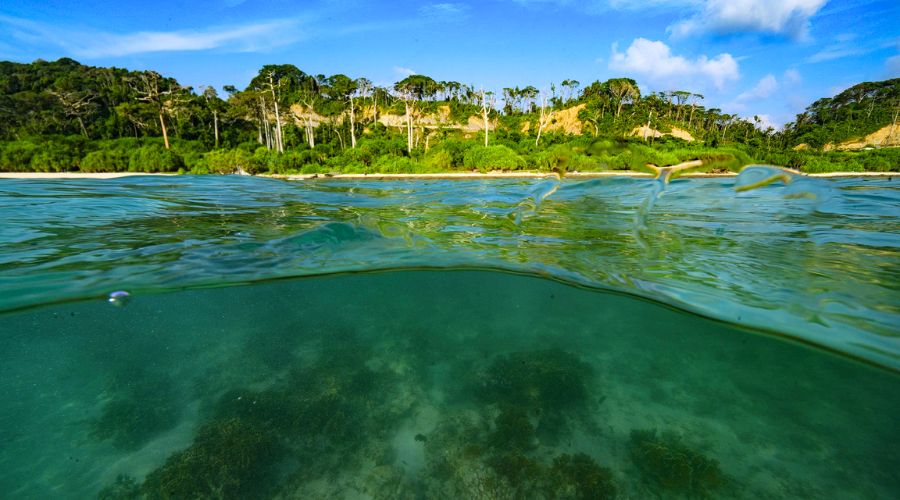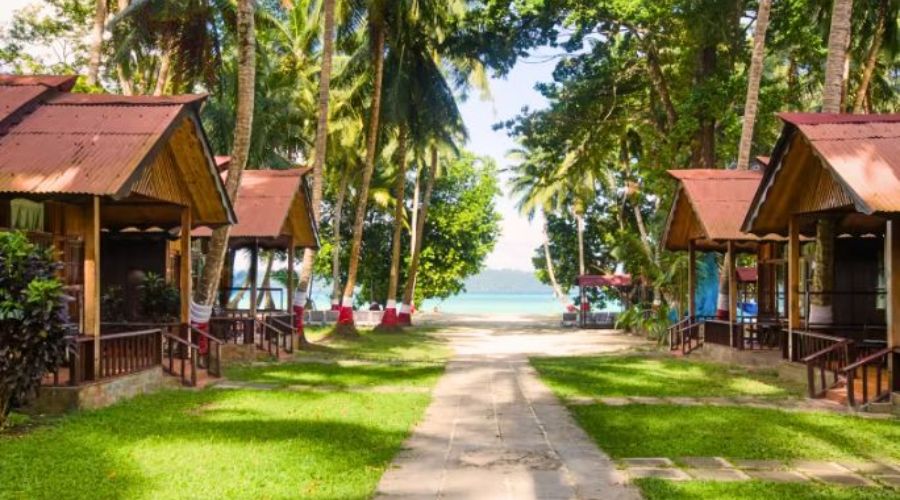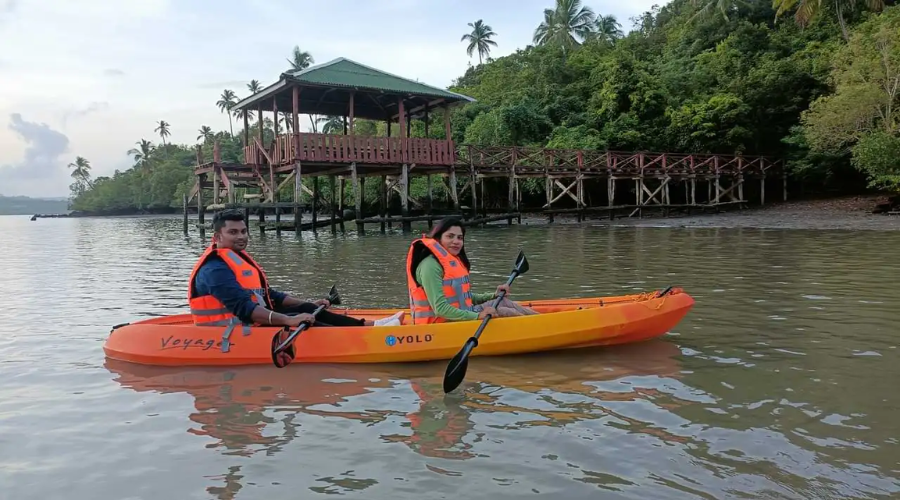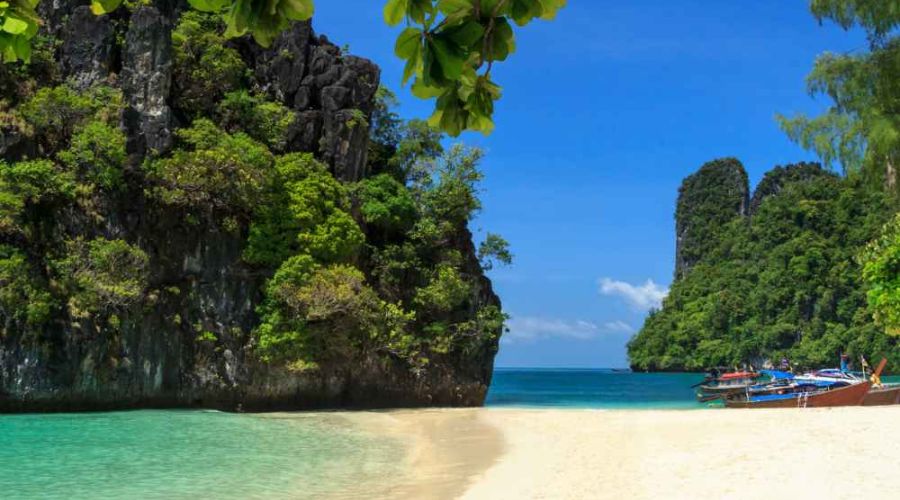The Great Nicobar Biosphere Reserve (GNBR), located in the southernmost part of the Nicobar Islands in the Andaman and Nicobar archipelago, is a globally significant ecological hotspot. It is known for its rich biodiversity, unique ecosystems and critical role in conservation. Key ecological characteristics of the GNBR include:
Suggested Read: Game fishing in Andaman and Things to do in Andaman
1. Unique Biodiversity
- Flora: The reserve hosts tropical evergreen forests, mangroves and littoral forests. Species like pandanus, casuarinas and endemic palms dominate the landscape. Many plant species found here are endemic, reflecting the reserve’s evolutionary uniqueness.
- Fauna: GNBR is home to several rare and endangered species. Notable species include the Nicobar megapode, saltwater crocodile, leatherback turtle and endemic species like the Nicobar tree shrew and the Nicobar macaque.
- Marine Life: Surrounding coral reefs and seagrass beds support diverse marine species, including dugongs, sea turtles and a variety of fish.
Suggested Read: Coral Reefs in Andaman
2. Protected Ecosystems
- The reserve features two important national parks: Campbell Bay National Park and Galathea National Park, which protect terrestrial and marine ecosystems.
- The area supports critical nesting sites for leatherback turtles, a species of global conservation concern.
3. Geological and Climatic Features
GNBR’s terrain includes coastal plains, hills and mangroves, shaped by tectonic activity and the influence of monsoons.
The climate is tropical, with high rainfall and humidity, supporting the lush vegetation and high biodiversity.

4. Cultural Importance
The biosphere reserve is home to indigenous communities like the Shompens and Nicobarese, who rely on the forests and marine resources sustainably and have a deep cultural connection with their environment.
5. Ecological Challenges
- The region is vulnerable to natural disasters such as tsunamis and cyclones.
- Human activities, such as deforestation and habitat fragmentation, along with invasive species, pose threats to its ecological balance.
Importance of GNBR
This reserve plays a vital role in preserving biodiversity, protecting endangered species and maintaining ecological processes. It is part of UNESCO’s World Network of Biosphere Reserves, emphasizing its significance in global conservation efforts.
Socioeconomic Characteristics of The Great Nicobar Biosphere Reserve (GNBR)

The Great Nicobar Biosphere Reserve (GNBR) exhibits unique socio-economic characteristics, shaped by its geographical isolation, rich natural resources and the indigenous communities that inhabit the region. These features reflect a balance between traditional lifestyles and modern development pressures.
1. Indigenous Communities
The reserve is home to two primary indigenous groups: the Shompens and the Nicobarese.
- Shompens: A semi-nomadic tribe, the Shompens primarily rely on hunting, gathering and small-scale horticulture for their livelihood. They inhabit the forest interiors and maintain a close connection with nature, adhering to traditional ways of life.
- Nicobarese: This community, relatively more modernized, engages in agriculture, fishing and livestock rearing. They often reside closer to coastal areas and practice sustainable resource use.
2. Livelihood and Resource Use
- Agriculture: Subsistence farming is prevalent, with crops like coconut, banana and tapioca being commonly cultivated. The Nicobarese also trade copra (dried coconut kernels) as an economic activity.
- Fishing: The surrounding marine resources provide fish and other seafood, which are essential for local consumption and small-scale trade.
- Forest Resources: Both communities depend on forest products such as honey, fruits, medicinal plants and timber for their daily needs.
Suggested Read: Local Life In Andaman islands
3. Economic Development

- Infrastructure development in the region is minimal due to its remoteness and the emphasis on ecological conservation. Most modern amenities are concentrated in administrative areas like Campbell Bay.
- Tourism, although limited due to ecological restrictions, provides a small source of income, with a focus on eco-tourism and adventure activities.
4. Challenges to Socio-Economic Stability
- Natural Disasters: The region’s vulnerability to events like tsunamis and cyclones (e.g., the 2004 Indian Ocean tsunami) disrupts the lives of local communities and hampers economic activities.
- Isolation: Limited connectivity to mainland India affects access to healthcare, education and economic opportunities.
- Conservation Restrictions: Strict regulations to protect the biosphere’s ecology limit extensive economic exploitation of resources, ensuring sustainability but constraining economic growth.
5. Government Support
- The Indian government and local authorities provide subsidies, healthcare and educational services to improve the quality of life for indigenous communities.
- Sustainable development programs aim to integrate conservation goals with livelihood enhancement for the resident population.
Balance Between Conservation and Livelihoods
The socio-economic dynamics of GNBR reflect a delicate balance between preserving the biosphere’s ecological integrity and supporting the livelihoods of its indigenous people. Sustainable practices and inclusive policies are key to maintaining this equilibrium.
Steps to Protect the Great Nicobar Biosphere Reserve
Protecting the Great Nicobar Biosphere Reserve (GNBR) requires a comprehensive approach that balances ecological preservation with sustainable development. Here are some key strategies:

1. Conservation of Biodiversity
- Protection of endemic species is important by implementing measures to safeguard rare and endangered species, such as the Nicobar megapode, Nicobar tree shrew and leatherback turtles.
- Habitat restoration should be done by rehabilitating degraded areas, such as mangroves and coral reefs, to maintain ecological balance and support biodiversity.
- Wildlife corridors should be created by establishing wildlife corridors to ensure the safe movement of animals and prevent habitat fragmentation.
2. Sustainable Resource Use
- Community-based management involves indigenous communities like the Shompens and Nicobarese in sustainable resource management practices.
- Sustainable fishing and agriculture practices should be promoted by eco-friendly fishing techniques and organic farming to prevent overexploitation and soil degradation.
- Regulating tourism is important. Limit tourist activities to eco-tourism and establish strict guidelines to minimize environmental impact.
3. Strengthening Legal and Administrative Frameworks
- Protected area management by enforcing existing conservation laws in Campbell Bay and Galathea National Parks within the biosphere reserve should be promoted.
- Buffer zone management should be carried out by strengthening monitoring and regulation in buffer zones to control human activities that could harm core areas.
- Regulating development projects through assessment of the ecological impact of infrastructure projects and limiting activities that could degrade the ecosystem.
4. Addressing Climate Change and Natural Disasters
- Disaster preparedness is needed by developing early warning systems and community-based disaster management plans to minimize damage from cyclones, tsunamis and other natural disasters.
- Climate resilience should be built by promoting afforestation and mangrove conservation to protect against coastal erosion and rising sea levels.
Suggested Read: Reason to visit Andaman
5. Scientific Research and Monitoring
- Biodiversity monitoring such as conduction of regular surveys to assess species populations and habitat health should be held.
- Climate studies should be continued to monitor climate change impacts and develop adaptive strategies for long-term conservation.
- Data sharing is to be done in collaboration with national and international organizations of the research findings and conservation techniques.
6. Community Involvement and Awareness
- Indigenous knowledge should be utilized. Incorporate traditional ecological knowledge of the Shompens and Nicobarese in conservation planning.
- Awareness campaigns should be conducted to educate local communities and tourists about the importance of preserving the biosphere reserve.
- Livelihood alternatives have to be thought about. Sustainable livelihood options, such as eco-tourism and handicrafts, to reduce dependence on natural resources should be provided.
7. Global Collaboration
- UNESCO Partnerships: Leverage the reserve’s designation as a UNESCO Biosphere Reserve to attract international support and funding for conservation projects.
- Capacity Building: Train local authorities and stakeholders in advanced conservation techniques.
- By integrating these strategies, the Great Nicobar Biosphere Reserve can be preserved as a critical ecological treasure while ensuring the well-being of its indigenous communities and wildlife.
Scope of Tourism in Great Nicobar Biosphere Reserve
Tourism in the Great Nicobar Biosphere Reserve is a unique experience, offering visitors an opportunity to explore one of the most ecologically significant regions in the world.
Tourism Highlights
- Biodiversity Exploration: Tourists can explore the lush tropical rainforests, mangroves and pristine beaches of the reserve. Opportunities to spot rare and endemic species like the Nicobar megapode, leatherback turtles and diverse marine life.
- Eco-Tourism: Sustainable eco-tourism activities are encouraged to minimize the ecological footprint. You can participate in guided nature walks, birdwatching and turtle nesting site visits.
- Cultural Interaction: While interactions with indigenous communities like the Shompens and Nicobarese are limited to preserve their privacy, tourists can learn about their sustainable lifestyles through cultural exhibits and workshops.
- Adventure Activities: Activities such as snorkelling and scuba diving around the coral reefs offer a glimpse into the vibrant marine ecosystems.
- National Parks: Campbell Bay National Park and Galathea National Park within the reserve provide opportunities for wildlife enthusiasts to explore unique flora and fauna.
Challenges and Guidelines for Tourism
- Accessibility: The Great Nicobar Biosphere Reserve is remote, with limited connectivity and infrastructure. Travel requires planning, often involving permits and transportation by boat or helicopter.
- Ecological Sensitivity: To protect the fragile ecosystem, tourism is strictly regulated. Visitors are required to follow eco-tourism guidelines, such as avoiding littering and respecting wildlife habitats.
- Limited Facilities: Accommodation options within the reserve are basic, and luxury tourism is not promoted to maintain ecological balance.
Promoting Responsible Tourism
- Awareness Campaigns: Educating visitors about the importance of conserving the biosphere reserve and the impact of their activities.
- Eco-Tourism Packages: Promoting guided eco-tourism packages that benefit local communities and support conservation efforts.
- Research and Volunteer Opportunities: Tourists interested in environmental conservation can engage in research programs or volunteer for initiatives like reforestation and marine conservation.
By prioritizing eco-tourism and conservation, tourism in the Great Nicobar Biosphere Reserve can become a model for sustainable development while offering a memorable experience for visitors. Let me know if you need more details or specific recommendations!


